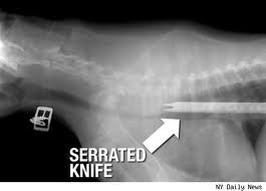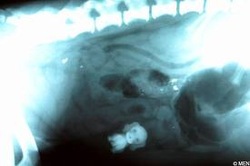Pets Will Eat Just About Anything

Rubber Duck in Dog's Stomach
Dogs and cats sometimes swallow things they shouldn't - and often things you would never think they even could. Dogs experience obstructions more often than cats because they love to chew and they end up swallowing nondigestible objects like sticks and stones. Cats tend to have problems with string-type toys like ribbons or with pieces of toys or feathers that can break off. Dogs and cats who have had one obstruction are at a higher risk for more. They may have the habit of swallowing the wrong things or develop scar tissue inside the intestines that makes it more difficult for even small items to pass. Wine corks, corn cobs, squeakers from toys, small balls, rawhide, socks and underwear are frequent causes of foreign body obstructions.
Foreign Body Obstructions

Any swallowed object has the potential to turn into an obstruction once it enters the digestive tract. Undigestable objects larger than the exit from the stomach, or those that catch father down once they've entered the intestines, can clog the digestive system, causing a blockage. As you can see from the pictures on this page, some obstructions can be diagnosed with plain x-rays if the swallowed object is dense enough to show up on the film or if it causes a complete blockage, leading to gas dilation of the stomach and intestines, also evident on x-ray (areas of gas or air are dark or black on an x-ray...can you see the dog's windpipe in the film above?).
Sometimes, the object moves within the system and causes only a partial or intermittent blockage. Your pet may feel fine one day, then acts sick the next. String-type objects like thread, tinsel, and ribbon are particularly dangerous, as they frequently "catch" somewhere in the gut and can cut the intestines during the normal muscular contractions of digestion. These types of obstructions are called linear foreign bodies; this is the type of obstruction that Charlie had. Although linear foreign body obstructions happen more often in cats, they have a much higher death rate in dogs. Partial and linear foreign body obstructions can be more difficult to diagnose through plain x-ray. Endoscopy or ultrasound may be necessary.
An intestinal obstruction is a medical emergency that requires immediate veterinary help and possibly surgery. Once the digestive tract becomes blocked, the stomach builds up gas and fluid from food and digestive juices that can't pass. Pets refuse to eat or drink and act sick or depressed. As the stomach swells, the stretch receptors reach their limit and signal the pet to vomit-this usually happens within 72 hours. Vomiting can also start sooner than this, even within hours of the object being ingested, as it begins to irritate the intestinal wall.
Sometimes, the object moves within the system and causes only a partial or intermittent blockage. Your pet may feel fine one day, then acts sick the next. String-type objects like thread, tinsel, and ribbon are particularly dangerous, as they frequently "catch" somewhere in the gut and can cut the intestines during the normal muscular contractions of digestion. These types of obstructions are called linear foreign bodies; this is the type of obstruction that Charlie had. Although linear foreign body obstructions happen more often in cats, they have a much higher death rate in dogs. Partial and linear foreign body obstructions can be more difficult to diagnose through plain x-ray. Endoscopy or ultrasound may be necessary.
An intestinal obstruction is a medical emergency that requires immediate veterinary help and possibly surgery. Once the digestive tract becomes blocked, the stomach builds up gas and fluid from food and digestive juices that can't pass. Pets refuse to eat or drink and act sick or depressed. As the stomach swells, the stretch receptors reach their limit and signal the pet to vomit-this usually happens within 72 hours. Vomiting can also start sooner than this, even within hours of the object being ingested, as it begins to irritate the intestinal wall.
Symptoms of an obstruction can vary depending on where it occurs in the digestive tract, although vomiting is the hallmark sign. Clinical signs include lethargy, refusal to eat or drink, vomiting, diarrhea, abdominal pain and distention, fever, weight loss, dehydration and shock. Just because a pet continues to have bowel movements does not rule out an intestinal obstruction. Dehydration and shock can occur rapidly when a pet is vomiting frequently. If you notice these symptoms, or if the vomiting is severe or prolonged and his condition is worsening, take your pet to the vet immediately.
Untreated obstruction becomes particularly dangerous if the blood supply in the intestines is cut off. This happens when the tissues around the obstruction swell and hinder the flow of blood. Without free blood flow, the tissues can die, allowing digestive acids and bacteria into the abdominal cavity. A pet in this situation has a very tender abdomen that can feel hard like a board. After a while, he goes into shock, his gums become pale, and he may collapse. To fight shock, wrap your pet in a blanket to keep him warm and put a drop or two of corn syrup or honey on his gums to help keep him conscious. Then get veterinary help immediately. The longer an animal is obstructed, the greater the risk for complications and the poorer the prognosis for recovery.
Sources: The First Aid Companion for Dogs & Cats (Amy D. Shojai), The 5-Minute Veterinary Consult, Canine and Feline (Larry P. Tilley and Francis W. K. Smith, Jr.), and The Merck Veterinary Manual (Susan E. Aiello, Editor)

